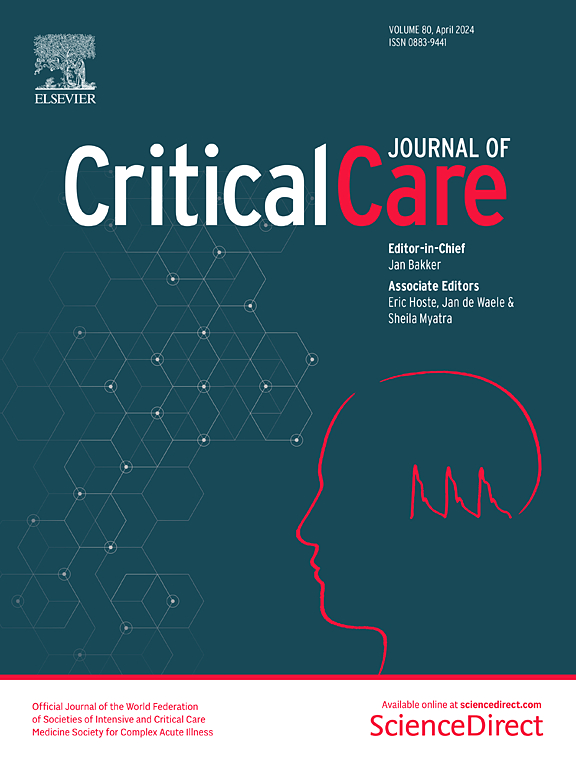入住重症监护室的心脏骤停患者的体液平衡与预后
IF 8.8
1区 医学
Q1 CRITICAL CARE MEDICINE
引用次数: 0
摘要
虽然心脏骤停后的休克很常见,并对死亡率有重大影响,但用于控制血液动力学情况的方式,特别是在液体平衡方面的影响仍不清楚。我们评估了体液平衡阳性与院外心脏骤停(OHCA)后预后之间的关系。我们于2020年8月至2022年6月进行了一项多中心研究,在17个重症监护病房连续招募成年OHCA患者。主要终点为90天生存期。进行多变量Cox分析、倾向评分匹配和里程碑分析,以及一些敏感性分析。在纳入我们研究的816例患者中,74%的患者体液平衡呈阳性,816例患者中有291例(36%)在90天存活。经校正多因素分析(HR = 1.8 [1.3 - 2.3], p < 0.001)、倾向评分匹配(n = 193对匹配患者,HR = 1.6 [1.1 - 2.1], p = 0.005)和里程碑分析后,体液平衡阳性与死亡率相关。我们报道了体液平衡与死亡率之间的剂量依赖关系。液体平衡阳性的患者更有可能需要肾脏替代治疗(10%对2%,p = 0.001),并且在前7天的最低PaO2/FiO2比率较低(158对180,p < 0.001)。心脏骤停后,体液平衡呈阳性始终与较差的结果相关。根据进一步的数据,限制性液体治疗策略可能对ohca后患者有益。试验注册:ClinicalTrial.gov队列AfterROSC-1 NCT04167891于2019年11月13日注册,伦理委员会2019- a01378 -49和pcp - smiv 190901。本文章由计算机程序翻译,如有差异,请以英文原文为准。
Fluid balance and outcome in cardiac arrest patients admitted to intensive care unit
Although shock following cardiac arrest is common and contributes significantly to mortality, the influence of the modalities used to manage the hemodynamic situation, particularly with regard to fluid balance, remains unclear. We evaluated the association between positive fluid balance and outcome after out-of-hospital cardiac arrest (OHCA). We conducted a multicenter study from August 2020 to June 2022, which consecutively enrolled adult OHCA patients in 17 intensive care units. The primary endpoint was 90-day survival. Multivariate Cox analysis, propensity score matching and landmark analysis were performed, along with several sensitivity analyses. Of the 816 patients included in our study, 74% had a positive fluid balance, and 291 of 816 patients (36%) were alive at 90-day. A positive fluid balance was associated with mortality after adjusted multivariate analysis (HR = 1.8 [1.3 – 2.3], p < 0.001), after propensity score matching (n = 193 matched patient pairs, HR = 1.6 [1.1 – 2.1], p = 0.005) and after landmark analysis. We reported a dose-dependent association between fluid balance and mortality. Patients with a positive fluid balance were more likely to need renal replacement therapy (10% vs. 2%, p = 0.001) and had a lower minimum PaO2/FiO2 ratio in the first seven days (158 vs. 180, p < 0.001). After cardiac arrest, a positive fluid balance is consistently associated with a worse outcome. Pending further data, a restrictive fluid therapy strategy may be beneficial in post-OHCA patients. Trial registration: ClinicalTrial.gov cohort AfterROSC-1 NCT04167891 registered November 13th, 2019, ethics committees 2019-A01378-49 and CPP-SMIV 190901.
求助全文
通过发布文献求助,成功后即可免费获取论文全文。
去求助
来源期刊

Critical Care
医学-危重病医学
CiteScore
20.60
自引率
3.30%
发文量
348
审稿时长
1.5 months
期刊介绍:
Critical Care is an esteemed international medical journal that undergoes a rigorous peer-review process to maintain its high quality standards. Its primary objective is to enhance the healthcare services offered to critically ill patients. To achieve this, the journal focuses on gathering, exchanging, disseminating, and endorsing evidence-based information that is highly relevant to intensivists. By doing so, Critical Care seeks to provide a thorough and inclusive examination of the intensive care field.
 求助内容:
求助内容: 应助结果提醒方式:
应助结果提醒方式:


